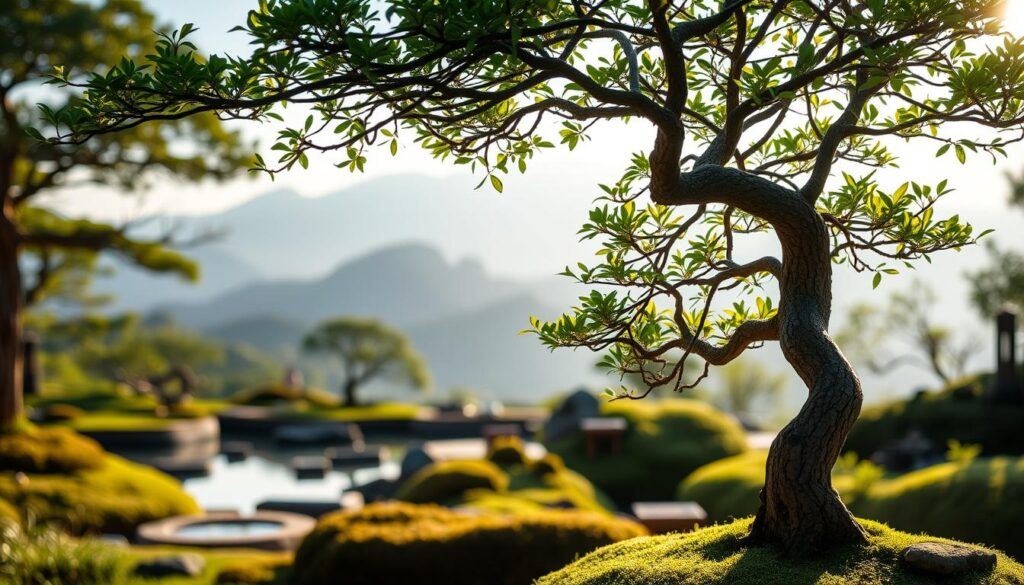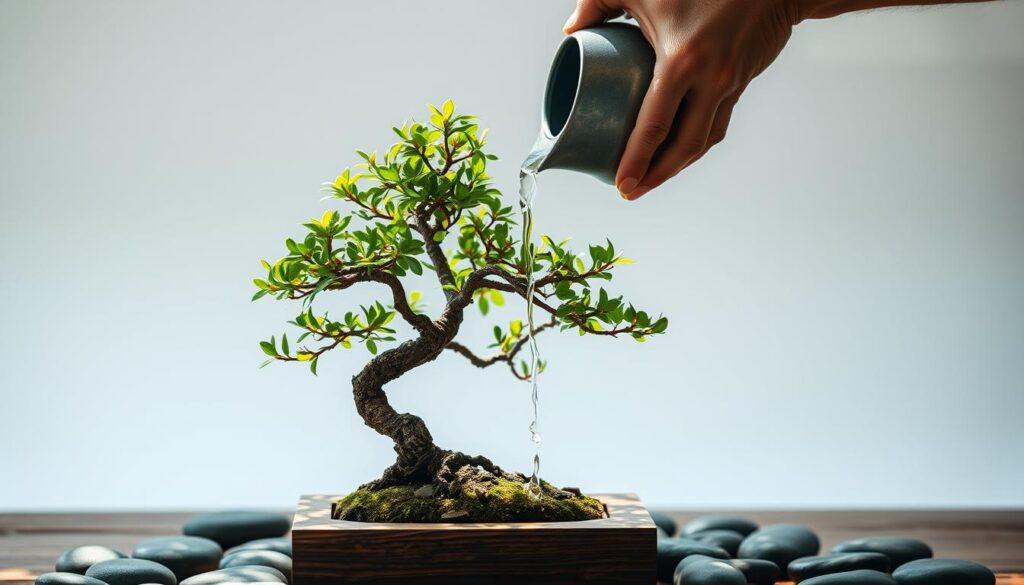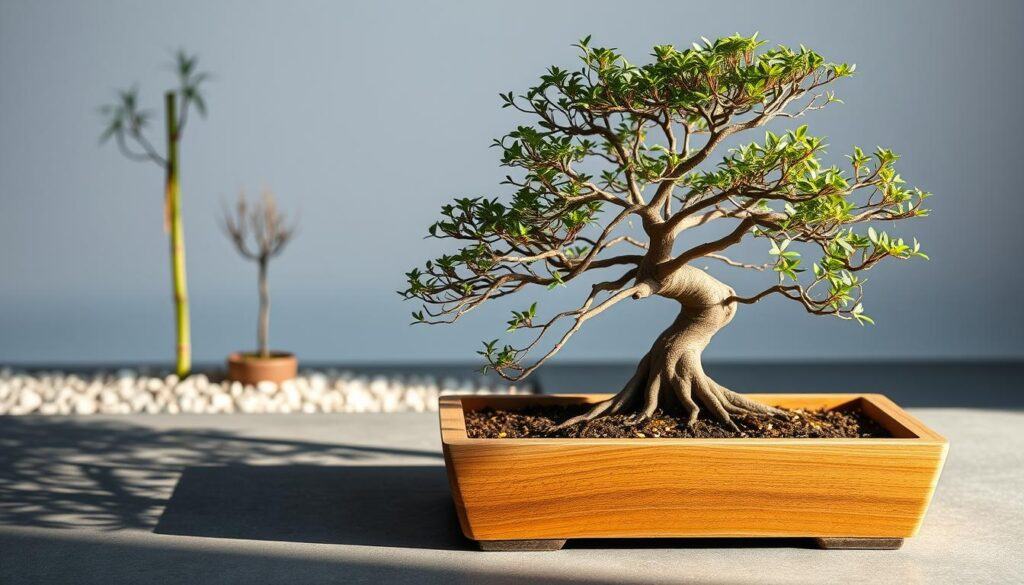The art of bonsai cultivation has deep historical roots, tracing back over a thousand years to ancient China and Japan. For beginners, understanding the basics of bonsai care is crucial to successfully growing these miniature trees.
Avoiding beginner mistakes in bonsai cultivation can make a significant difference in the health and aesthetic appeal of your trees. By being aware of common pitfalls, new enthusiasts can better care for their bonsai, ensuring they thrive.
Key Takeaways
- Understand the historical context of bonsai cultivation.
- Learn the basics of bonsai care to avoid common mistakes.
- Recognize the importance of proper watering techniques.
- Familiarize yourself with different bonsai styles.
- Start with beginner-friendly bonsai species.
The Enchanting World of Bonsai
The art of bonsai has been a revered tradition for centuries, originating in ancient China and later flourishing in Japan. This ancient practice is not just about growing trees; it’s an art form that requires patience, dedication, and a deep understanding of nature. Bonsai cultivation involves carefully shaping and training trees to create miniature versions of full-sized trees, emphasizing harmony between human creativity and natural beauty.

Bonsai trees are living sculptures that embody the principles of bonsai aesthetics, focusing on balance, proportion, and simplicity. The history of bonsai is rich, with various techniques evolving over time. By practicing bonsai cultivation, enthusiasts can cultivate a sense of mindfulness and connection with nature.
5 Common Mistakes Beginning Bonsai Owners Make
As a beginner in the art of bonsai, it’s easy to fall into common pitfalls that can hinder your tree’s growth and overall health. Understanding these mistakes is crucial to nurturing a thriving bonsai. Here, we’ll explore five common errors and how to correct them.
1. Overwatering or Underwatering Your Tree
Proper watering is a delicate balance. Overwatering can cause roots to rot, while underwatering can lead to dehydration.
Signs of Improper Watering
Signs of overwatering include yellowing leaves and a soft, mushy trunk base. Underwatering is indicated by dry, brittle leaves and a slow growth rate.
How to Develop the Right Watering Rhythm
To find the right balance, check the soil moisture daily. Water thoroughly when the top inch of soil feels dry. Adjust based on climate, pot size, and species.

2. Selecting Species Unsuited to Your Climate
Choosing a bonsai species that thrives in your local climate is vital. Some species are sensitive to extreme temperatures or humidity levels.
Climate-Compatible Bonsai Options
For colder climates, consider species like Ficus or Juniper. In warmer climates, Juniper and Maple can thrive.
Indoor vs. Outdoor Considerations
Indoor bonsai trees prefer temperatures between 65-75°F (18-24°C), while outdoor trees can tolerate a wider range. Ensure your tree’s needs match your environment.
3. Aggressive or Improper Pruning Techniques
Pruning is essential for shaping your bonsai, but improper techniques can damage the tree.
Timing Your Pruning Sessions
Prune during the dormant season for most species. Avoid pruning during active growth periods unless necessary.
Tools and Techniques for Healthy Shaping
Use sharp, sterile tools to prevent infection. Techniques include pinching, wiring, and cutting back. Research the specific needs of your species.
4. Using Generic Potting Soil and Inadequate Containers
The right soil and pot are crucial for healthy root development and overall tree health.
Ideal Soil Composition for Bonsai
A mix of akadama, pumice, and lava rock provides good drainage and aeration. Avoid regular potting soil, as it can retain too much water.
Choosing the Right Pot Size and Style
Select a pot that complements the tree’s size and style. Ensure it has drainage holes to prevent waterlogging.
5. Placing Your Bonsai in Poor Lighting Conditions
Lighting is critical for photosynthesis and overall health. Different species have different lighting needs.
Understanding Species-Specific Light Needs
Some species, like Ficus, can tolerate low light, while others, like Juniper, require full sun. Research your tree’s needs.
Seasonal Light Adjustments
Adjust your bonsai’s placement seasonally to accommodate changing light patterns. Move outdoor trees to sheltered areas during extreme weather.
By avoiding these common mistakes, beginners can set themselves up for success in the rewarding world of bonsai cultivation.
Nurturing Your Bonsai Journey: Essential Success Strategies
Achieving success with bonsai requires a combination of knowledge, patience, and the right approach. To nurture your bonsai effectively, consider implementing a few key strategies that can significantly enhance your chances of success.
Creating a Seasonal Care Calendar
Developing a bonsai care calendar helps you stay organized and ensure your tree receives the right care at the right time. This calendar should outline the specific needs of your bonsai species during different seasons, including watering, pruning, and fertilization schedules.
Building a Supportive Bonsai Community
Connecting with a bonsai community can provide valuable support and knowledge sharing opportunities. Join local bonsai clubs or online forums to learn from experienced growers, share tips, and gain insights into best practices.
Conclusion
Cultivating bonsai is a path of patience, care, and growth, reminding us to appreciate nature’s beauty. By avoiding common mistakes like overwatering and improper pruning, and adopting successful strategies such as creating a seasonal care calendar, you can ensure a thriving bonsai. As you nurture your tree, you’ll discover the joy of shaping and caring for a living work of art.
A bonsai summary highlights the importance of understanding your tree’s needs and adapting to its unique requirements. As you continue on your bonsai journey, remember that every decision, from species selection to lighting conditions, contributes to the overall health and aesthetic of your tree, leading to a fulfilling bonsai conclusion.
FAQ
What is the ideal frequency for watering a bonsai tree?
The frequency of watering a bonsai tree depends on factors such as species, climate, and soil composition. Check the soil moisture by inserting a finger into the soil, and water when it feels dry.
How do I choose the right bonsai species for my climate?
Select a bonsai species that is tolerant of your local temperature and humidity conditions. Research the specific needs of the species you’re interested in to ensure it thrives in your environment.
What are the benefits of joining a bonsai community?
Joining a bonsai community provides opportunities to learn from experienced growers, share knowledge, and gain support. It can be a great way to stay motivated and inspired on your bonsai journey.
How often should I prune my bonsai tree?
Pruning frequency depends on the species and growth rate of your bonsai tree. Regular pruning is necessary to maintain shape and promote healthy growth, but avoid over-pruning, which can cause stress.
What type of soil is best for bonsai trees?
Bonsai trees require well-draining, nutrient-rich soil. Use a specialized bonsai potting mix that is designed to retain moisture but prevent waterlogging.
How can I protect my bonsai from extreme temperatures?
Protect your bonsai from extreme temperatures by placing it in a sheltered location or using protective covering. Research the specific temperature tolerance of your bonsai species to ensure you’re providing the right conditions.
What is the importance of creating a seasonal care calendar for my bonsai?
Creating a seasonal care calendar helps you stay organized and ensure your bonsai receives the right care at the right time. It allows you to plan for seasonal tasks, such as repotting and pruning.
